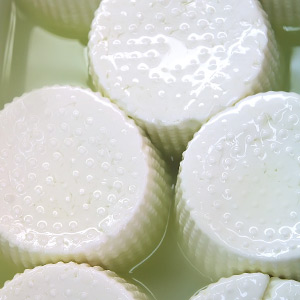Soft-Curd Cheeses

The soft-curd cheese family is divided into two categories: bloomy-rind cheeses and washed-rind cheeses.
Characteristics:
Served with fresh bread and fruit or a nice glass of red wine, soft-curd cheeses are a great way to end a meal. In fact, soft-curd cheeses are always a favourite at wine and cheese tastings. However, to bring out their full flavour and creamy texture, soft-curd cheeses should be served at room temperature, so always be sure to take them out of the refrigerator one hour before serving.
Purchasing Tips
The outside curd should be white, though some varieties also have golden grooves. The inside curd should be a creamy colour. Other signs of freshness include a mushroom flavour and an unctuous and creamy texture.
Avoid a greyish-coloured rind, a pink or grey curd, an ammonia odour or a runny texture; all signs that the cheese is not fresh.
Storage
As a rule, soft-curd cheeses should be tightly wrapped to prevent drying. They can be stored for several days wrapped in waxed paper and then covered with foil. The cheese should be stored at the bottom of the refrigerator, away from food with strong odours that could be absorbed.
To check if your cheese is still fresh, look for a mushroom aroma and see if the rind will yield slightly with a little pressure. Avoid those with a spicy or ammonia odour—a sign that your cheese has aged too much.
Freezing
Although the flavour will not be affected, freezing will alter a soft-curd cheese’s delicate texture, particularly a bloomy-rind cheese. Instead of freezing, use leftovers in soups or salads. If you must freeze the cheese, wrap in foil and place it in an airtight, re-sealable plastic freezer bag. Always refrigerate before freezing and defrost in the refrigerator to restore any moisture loss.
Basmati is a master of versatility, so go ahead and use it in soups, pilafs, stuffing, curries, as fried rice or Indian biryani. The only catch is that basmati hardens as it cools, so it's not suitable in cold dishes.


Bloomy-Rind Soft-Curd Cheeses
These cheeses are covered with a velvety-white duvet called “the bloom”. The bloom is obtained when Penicillum Candidum is added to the curd’s surface. This process is called “surface-ripening” and is a maturing process that begins on the surface of the cheese and progresses inwards. A rind then forms and protects the cheese while giving it a unique flavour. Soft curds are not pressed nor are they cooked.
Characteristics
Bloomy-rind soft-curd cheeses have a creamy texture and a mushroom aroma; an unctuous and supple texture and a pale yellow curd. These cheeses have a 20% to 33% fat content and 50% to 60% moisture content.
Varieties of Bloomy-Rind Soft-Curd Cheeses
This category offers a nice variety of choices including Biquet, Boursault, Brie double crème, Brie de Vaudreuil, Camembert, Caprice des Dieux, Chèvrechon, Feta, Neufchâtel au lait cru, Paillot de chèvre, Saint-André and Saint-Honoré.
Have You Tried Saint-Honoré?
It is originally from France but it is also produced here in Québec, in Saint-Raymond-de-Portneuf. The rind is white and velvety, the curd is creamy white and very unctuous. The Saint-Honoré has a distinctive mushroom flavour and, depending on the degree of ageing, it also exhibits a milky taste with a nutty flavour.
Washed-Rind Soft-Curd Cheeses
This type of cheese is made in much the same way as bloomy-rind soft-curd cheeses except that, during the ripening period, the cheese is frequently washed and brushed with a salty solution enriched with “healthy” bacteria, hence the name “washed-rind”.
Characteristics
Washed-rind cheeses are known for their delicate aroma of fruit, cream and hazelnut. They have a soft and unctuous consistency with an elastic curd. Washed-rinds have a more pronounced flavour and aroma than bloomy-rinds. They have a 20% to 33% fat content and 50% to 60% moisture content.
Varieties of Washed-Rind Soft-Curd Cheeses
Some of the unique and flavourful cheeses you will find in store include Empereur, Providence d’Oka, Saint-Damase and Sir Laurier d’Arthabaska.
Have You Tried Pont-l’Évêque?
The Pont-l’Évêque comes from the Normandy region and is one of the oldest soft-curd cheeses ever made. Depending on the ripening and storing process used, this cheese can evolve into either a bloomy-rind cheese or a washed-rind cheese. If ripening takes place in dry environment, the rind is thick and grey. When the cheese is ripened in a humid environment, the rind is smooth, thin and orange.

| Fat content | 20% to 33% |
| Mositure content | 50% to 60% |
| Refrigeration |
|
| Upon purchase (Look for) | Outside: White curd (sometimes with golden grooves as well) Inside: Cream-coloured curd. |
| Upon purchase (Avoid) | Outside: Grey curd Inside: Pink or grey curd. Ammonia odour. Runny texture. |





